

Basic knowledge of first aid measures and standard rescue procedures is vitally important to rural residents.
Quite
simply, medical assistance and emergency rescue personnel
usually have to cover a greater distance than would be the
case in an urban setting. Life may hang in the balance during
those extra few minutes it takes for help to arrive. Your
ability to deal with an emergency can most certainly mean
the difference between life and death!
There
is a strong element in human nature that leads us to ignore
the possibility of disaster striking our lives -- it always
happens to 'the other guy'. We have to make a conscious effort
to prepare for emergencies, even though such situations seem
to be impossibly remote from our day-to-day lives.
Ideally,
there should be at least two individuals on every farm with
first aid training. What happens if just one person has knowledge
of first aid procedures, and it is that individual who gets
hurt?
Knowledge
of what to do in an emergency situation is vital. Develop
a file of information on measures for dealing with accidents,
health problems and natural disasters.
Prepare
a 'what if' plan that involves everyone living or working
on your farm. Each person should have a good basic grounding
in how to deal with emergencies. Knowledge and preparedness
are the best antidotes for panic and fear -- calmness also
reassures an accident victim.
When confronted
by an emergency, assess the situation carefully. Calmly decide
what steps need to be taken, and in what order.
In many
cases, speed is vital. Work quickly and do your best
with the available resources.
Remember
that first aid is temporary, on-the-spot assistance. It is
not a substitute for expert medical care. Call for
help as soon as possible. Telephone numbers of emergency medical
services, rescue experts, fire department, and police should
be posted by every telephone as part of your 'what if' plan.
Can you quickly and accurately describe the precise location
of your farm?
Provide
aid agencies with as much information as possible regarding
the emergency. Rescue teams and medical personnel will be
able to think out a strategy en route if they are given basic
information on the nature of the emergency. Special procedures
may be required to free a victim who is entangled in heavy
equipment, for example. If an accident has occurred in a muddy
field, access may require a four-wheel-drive vehicle. Such
information could save valuable minutes from the time required
for rescue.
In any emergency,
physical care for the victim(s) is priority one. Establish breathing
and heart function -- if either has stopped, immediate resuscitation
procedures are essential to survival (see page 4). Control bleeding
and administer other required first aid. Psychological reassurance
and physical warmth can also improve a victim's survival chances.
It isn't
possible to detail rescue procedures for every type of emergency
in such limited space. The following pages highlight measures
for dealing with some of the most common farm accident situations.
Information
on rescue procedures for a wide variety of on-farm emergencies
may be obtained from extension services, health facilities,
insurance companies, fire departments, St John Ambulance,
and a variety of other sources. Readers are urged to acquire
this information and use it to develop contingency plans.
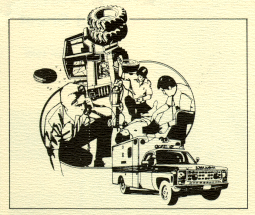
Victims
of tractor overturns usually suffer crushing injuries to the
head, chest and pelvic areas. Movement may aggravate injuries
and cause extensive internal bleeding. In many cases, it is
best to transport the victim in the position found.
Emergency
medical and rescue personnel should be summoned to deal with
tractor accidents. Overturns frequently result in fatalities.
At best, entrapment and serious injury are likely to be encountered
Following
are key points to consider during a tractor rollover rescue:
- Fire
is a threat in an overturn situation, since large amounts
of spilled fuel are often present. A charged fire hose or
an ABC-type extinguisher should be available throughout
the rescue.
Because of the fire-hazard, rescuers should consider alternative
methods before using oxyacetylene cutting equipment to free
a victim.
- Shut
off the engine -- even if it isn't running, rear wheel movement
could start it up.
- If
the ground is soft, it may be possible to dig the victim
out from under the tractor. Always block or crib the machine
to prevent it from tipping and causing further injuries.
- Lifting
is the preferred method for dealing with rollovers of large,
modern tractors. A second tractor or a tow truck will be
needed to perform the lift.
If a tractor must be rolled away from the victim, careful
blocking is required to minimize settling of the lower side.
- Place
cribbing under the tractor as it is raised. Non-essential
rescuers should stand well clear to avoid injury in the
event of cable or chain breakage.
- Hydraulic
jacks can be used to lift smaller tractors (up to 10,000
pounds in weight). Block the axle on both sides to
prevent the tractor from rocking onto the victim.
- Air
bags can be used to raise an overturned tractor. They are
more stable if stacked alternately with the blocking.
- If
a victim is pinned under one side of a small tractor, eight
to ten men may be able to roll the machine enough to permit
extrication.
- Block
the implement to ensure firm support throughout the rescue.
- Attempt
to telescope the two ends of the PTO shaft apart. It may be
necessary to roll the tractor ahead to slide the stub shaft
out of the front yoke, or to separate the shaft.
- Single-piece
PTO shafts may have to be cut or disassembled at either end
to free the victim.
- It
may be possible to free the victim by turning the shaft backward.
Under no circumstances should tractor power be used to
rotate the shaft!
- Sometimes
it is best to transport a stabilized victim still entangled
with part of the PTO shaft. Extrication can be completed by
a surgeon under hospital conditions.
- All
amputated tissue should be transported to the hospital with
the victim (see page 4).
- Spine
and neck injuries are common in PTO entanglements. Appropriate
stabilization procedures must be followed.
- If
the accident involves complex or unfamiliar equipment, seek
advice from a local implement dealer. This may prove to be
faster and more efficient than the trial and error approach.
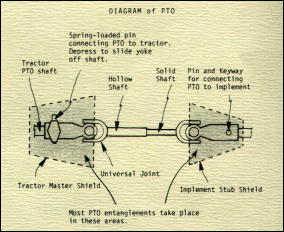
- Always
assume that any downed power line or any piece of equipment
in contact with a power line is energized! If the victim is
still in contact with the downed line or energized equipment, do not touch him/her. Direct contact with the injured
party is certain to make you a secondary victim!
- If
you have not been trained to handle high voltage lines, call
Ontario Hydro or your local utility company for emergency
assistance. You can then protect the accident site until help
arrives.
- Only
if it appears that the response time will be dangerously long
should an untrained individual attempt a rescue. Wear rubber-soled
boots and nonconductive gloves. Use a dry board or
a tool with a long wooden handle to remove the power line.
If the victim is in contact with energized equipment, it will
be necessary to push or pull them away. A piece of dry, nonconductive
rope can be used for this purpose.
- Check
for breathing as soon as the victim is freed from electrical
contact. Start artificial respiration immediately if required.
Mouth-to-mouth resuscitation has saved many electrical shock
victims. Cardiac resuscitation may also be necessary (see
page 4).
- Anyone
who has received a high voltage electrical shock should be
examined by a doctor as soon as possible. Physical damage
may have occurred, even though the victim appears to 'feel
fine'.
Most silo
rescue situations will require extrication by litter, backboard,
body sling, or harness.
The Hillsburgh,
Ontario Fire Department has developed a simple device that
allows a trained rescue team to extricate a victim in 30 minutes
or less. The equipment is economical and can easily be fabricated
by a local welding shop.
Because
of the complexities involved in extricating accident victims
from silos, rescue procedures must be carried out by trained
personnel. Following are a few cautionary notes concerning
silo rescues:
- Self-contained
breathing equipment is a must for rescue personnel if there
is even a remote chance that silo gas may be present in
the structure. Remote air lines are usually required, since
a back pack of air is too bulky to wear inside of the silo
chute.
- Lift
the victim off the silage surface immediately to get them
away from the area of potential gas concentration.
- Rescue
teams should be equipped with sufficient rope to lift a
victim out of the tallest silo, regardless of the silage
level.
- Be
certain that the silo unloader cannot be switched
on during rescue and extrication procedures.
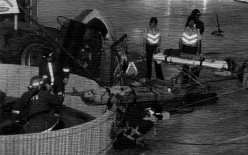
Silo
rescue must be carried out by trained personnel.
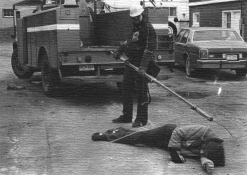
Use
a dry wooden tool to remove a downed power line in an emergency
only (Caution: some wooden handles or boards can conduct
electricity).
While you
may be well prepared for emergency situations, it usually isn't
possible for an individual or farm family to handle a major
crisis completely on their own.
Communities
must be ready to assist when emergencies strike. A good emergency
medical service is needed to respond quickly, carry out rescue
procedures, administer proper treatment and transport victims
to the hospital. Adequate police and fire protection are also
vital elements of emergency rescue.
Many
rural communities cannot provide competent service in all
key areas. However, good planning, cooperation, wise use of
available resources and working closely with other municipalities
could improve many existing services.
- Gases
present in and around liquid manure storage facilities are extremely
toxic. Rescue personnel must use self-contained breathing equipment
at all times. To safely enter a manure storage pit, an
individual must have that supply of air and assistance from
a back-up crew using a life line.
- Restore
ventilation to facilities with beneath-the-floor manure storage
as rapidly as possible. Open windows and doors, activate the
building's ventilation system, or use smoke evacuation equipment.
- If
there is any possibility of reviving a victim, cardiopulmonary
resuscitation procedures should begin immediately (see page
4).
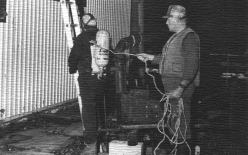
Self-contained
breathing equipment is essential for safe manure storage entry.

It is rather
gruesome to think about searching for a severed hand or a missing
limb at an accident site. However, recovery of amputated tissue
is extremely important. Modern surgical techniques have made
it possible to restore badly mangled tissue and reattach limbs.
If breathing
and blood circulation stop, a victim is a scant four minutes
away from permanent brain damage! Life quickly slips away from
a body that is deprived of oxygen.
Cardiopulmonary
resuscitation (CPR) combines mouth-to-mouth breathing with
external cardiac compression to maintain circulation for life
support. In a rural emergency, CPR may be the only way of
keeping a heart attack or accident victim alive until help
arrives.
Experts
say that CPR procedures should not be attempted without formal
training. All rural residents would be well advised to develop
competence in this life-saving technique. CPR classes are
held in most communities on a fairly regular basis.
Publication #: F-002
The information
and recommendations contained in this publication are believed
to be reliable and representative of contemporary expert opinion
on the subject material. The Farm Safety Association does not
guarantee absolute accuracy or sufficiency of subject material,
nor can it accept responsibility for health and safety recommendations
that may have been omitted due to particular and exceptional
conditions and circumstances.
SEPTEMBER 1985
Farm
Safety Association Home Page
Disclaimer and Reproduction Information: Information in
NASD does not represent NIOSH policy. Information included in
NASD appears by permission of the author and/or copyright holder.
More







